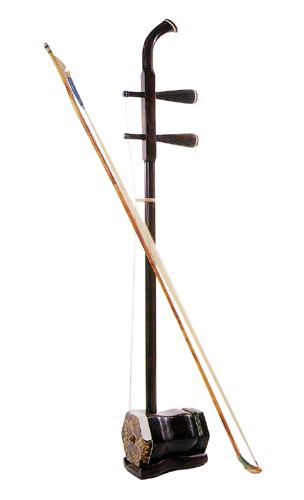 |
||||||||
ErHu |
||||||||
 |
The erhu (Chinese: 二胡; pinyin: èrhú), also called nanhu
(南胡, "southern fiddle"), and sometimes known in the West as
the "Chinese violin" or "Chinese two-string fiddle,"
is a two-stringed bowed musical instrument, used as a solo instrument
as well as in small ensembles and large orchestras. It is the most popular instrument in the huqin (胡琴) family of Chinese bowed string instruments, together with the zhonghu (中胡), gaohu (高胡), banhu (板胡), jinghu (京胡), sihu (四胡), and numerous others. Similarly, the bow passes between the two strings as is common with all Chinese Bowed instruments - Click for image The erhu consists of a long vertical stick-like neck, at the top of which are two large tuning pegs, and at the bottom is a small resonator body (sound box) which is covered with python skin on the front (playing) end. Two strings are attached from the pegs to the base, and a small loop of string (qian jin) placed around the neck and strings acting as a nut pulls the strings towards the skin, holding a small wooden bridge in place. Various dense and heavy hardwoods are used in making the erhu. According to Chinese references the woods include zi tan (紫檀 red sandalwood and other woods of the genus Pterocarpus such as padauk), lao hong mu (老红木 aged red wood), wu mu (乌木 black wood), and hong mu (红木 red wood). Particularly fine erhus are often made from pieces of old furniture. A typical erhu measures 81cm from top to bottom, the length of the bow also being 81cm. Tuning The erhu is almost always tuned to the interval of a fifth. The inside string (nearest to player) is generally tuned to D4 and the outside string to A4. This is the same as the two middle strings of the violin. Position The erhu is played sitting down placed on the top of the left thigh. Source: http://en.wikipedia.org/wiki/Erhu Extracts reproduced underCreative Commons license |
|||||||
|
||||||||